White dwarfs
Most of the stars we see in the sky have an initial mass
of from 0.075 to 8 solar mass![]() ; these stars produce energy by thermonuclear reactions
; these stars produce energy by thermonuclear reactions![]() : they transform hydrogen into helium, helium into carbon and carbon into oxygen. At the end of the star's life its radius increases
a lot, the temperature decreases and the star becomes a red supergiant
: they transform hydrogen into helium, helium into carbon and carbon into oxygen. At the end of the star's life its radius increases
a lot, the temperature decreases and the star becomes a red supergiant![]() .
.
This type of star burns hydrogen in a thin shell around the star's nucleus; when the nuclear fuel is depleted the star becomes unstable and an intense mass is lost, even 0.1% solar mass![]() per year, at a speed of 1000 km/sec.
This means that nearly all of the external mass is progressively removed. The ejected gas forms many expanding shells around the star, which is reduced to a small nucleus made by carbon and oxygen (Fig. 1 and
animation).
per year, at a speed of 1000 km/sec.
This means that nearly all of the external mass is progressively removed. The ejected gas forms many expanding shells around the star, which is reduced to a small nucleus made by carbon and oxygen (Fig. 1 and
animation).
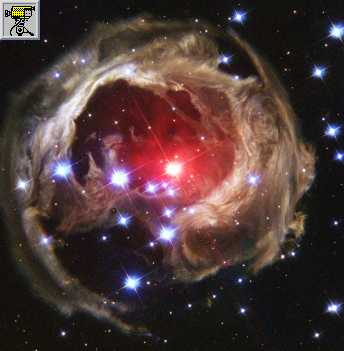 |
Fig 1:The red supergiant V838 Monocerotis photo and
animation. It is located 20000 light years (Credit: Photo NASA, STScI, ESA; 04/03/2004, movie 26/03/2003) |
At high temperature (even 200000 oK) the nucleus produces ultraviolet radiation![]() , which excites the electrons of the expanding gas. These electrons
return to their initial state by jumping to lower energy levels
, which excites the electrons of the expanding gas. These electrons
return to their initial state by jumping to lower energy levels![]() and emitting optical photons of various energy.
and emitting optical photons of various energy.
In the XVIII century W. Herschel called these objects planetary nebulae![]() , because from the Earth they look like a coloured object around a central planet.
, because from the Earth they look like a coloured object around a central planet.
The planetary nebulae have different shapes: sphere, ellipse (Fig. 2), ant (Fig. 3), sandglass (Fig. 4), flower (Fig. 5).
When the shells are completely scattered into space,
there remains a very hot star having the size of the Earth (radius=6370 km): a white dwarf (WD); these stars cool down over a
period of time longer than the age of the universe.
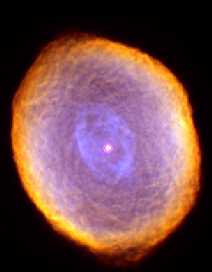 |
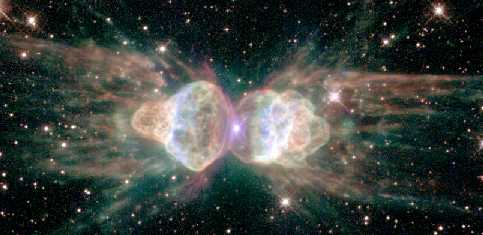 |
| Fig 2: The planetary nebula IC418 photo; this object is located 2000 light years from the Earth, in the Hare constellation . (Credit: Photo NASA, STScI; 07/09/2000) |
Fig 3: The planetary nebula Menzel 3, also called "Ant Nebula", because there are two lobes
coming out of the future white dwarf and
straight wide structures (like insect legs). The future white dwarf is the central little star having a initial temperature af 100000 oK; this star cools down because no thermonuclear reactions are present. (Credit:Photo NASA, ESA; 01/02/2001) |
It will take 5 billion years for the Sun to become a white dwarf; after Mercury and Venus, the Earth
too will be swallowed in the red supergiant phase.
Sirius B, the weak companion of Sirius A (the brightest star in the sky), was the first white dwarf discovered by Clark in 1862. This star has
a 1.053 solar mass, a surface temperature of 27000oK, a radius of 5500 km (=.86 times the Earth's radius).
Its surface gravity is 470000 times the Earth's gravity and its density is 3 million times more than the density of water.
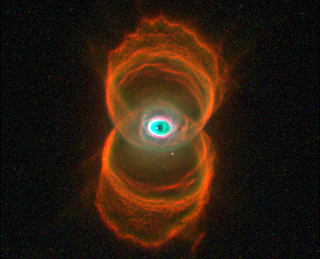 Fig. 4: The planetary nebula MyCn18 located 8000 light years from the Earth, in Fly constellation. The sandglass shape is possibly ,the result of a fast expanding stellar wind into a slowly expanding cloud that is denser in equatorial regions than in polar ones. To explain the structure of this planetary nebula we need to assume that the central star has an invisible companion. (Credit: Photo JPL, NASA; 16/01/1996) |
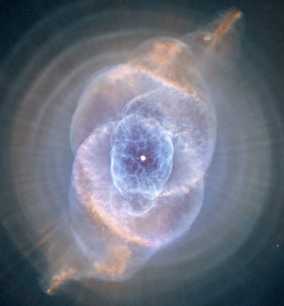 Fig. 5: Image of NGC 6543, the most beautiful planetary nebula in the sky located 3000 light years from us in the Dragon constellation. It is possible to see the concentric shells emitted from the central star: one every 1500 years. (Credit: Photo NASA, ESA; 09/09/2004) |
The age of the Universe is 14 billion years, so only the stars with an initial mass
of more than 0.8 solar mass can evolve into a white dwarf.
The white dwarf is a degenerate star![]() : the electronic pression balances the gravitational force, if its mass is less than 1.44 solar mass.
: the electronic pression balances the gravitational force, if its mass is less than 1.44 solar mass.
If the white dwarf is accreted by a companion when its mass exceeds 1.44
solar mass, the equilibrium between electronic pressure and gravity is
destroyed and the white dwarf explodes as a type Ia supernova![]() , and its mass is completely ejected into space. This is another way that
a star may die.
, and its mass is completely ejected into space. This is another way that
a star may die.